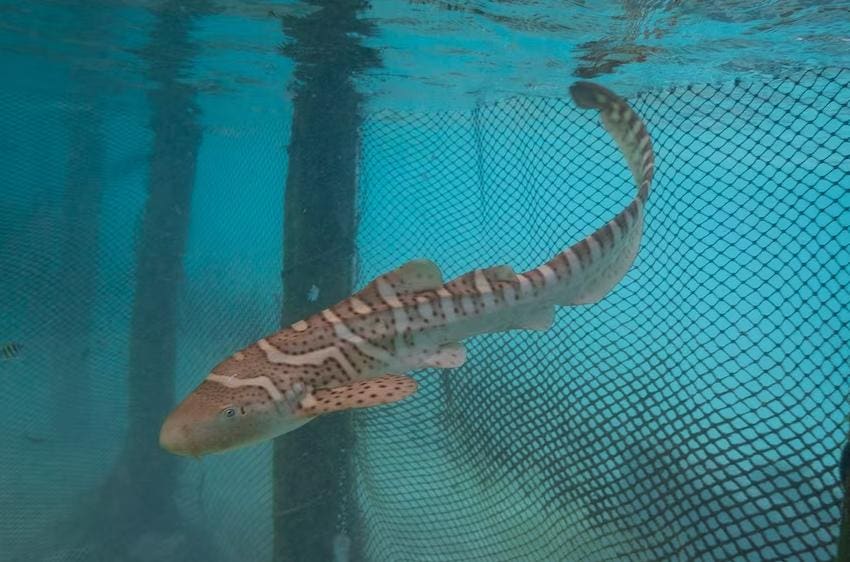Once abundant in the clear waters around Indonesia’s Raja Ampat islands, zebra sharks (Stegostoma tigrinum) were admired for their striking beauty. However, unregulated fishing in the 1990s and early 2000s, mainly for their fins and meat, led to a drastic decline in their numbers. “[Today] it is very rare to see them … The population has been deemed to be no longer genetically or sustainably viable,” Laura Simmons, the regional curator for Sea Life Australia and New Zealand, told ABC RN’s Saturday Extra.
The International Union for Conservation of Nature classifies zebra sharks as endangered, and in certain areas like Raja Ampat, they have nearly vanished despite recent government marine protection efforts in the Indonesian islands. But now, a groundbreaking initiative is underway to help out the zebra shark population, and if successful, it could serve as a model for restoring other marine ecosystems damaged by human activity. Thus, a collaborative effort involving 19 countries, led by the ReShark organization, is implementing a “shark rewilding” project in Raja Ampat’s waters.
Rewilding isn’t a new concept – it has been previously applied to animals like platypuses in Sydney and giant pandas in China. But this is the first it is being tried with sharks. Since nearby Australia has managed to maintain a relatively healthy zebra shark population due to established government protections, it is one of the countries that has put their hand up to help. At Sea Life Sydney Aquarium, the breeding project involves two male zebra sharks named Leo and Gohan, and two females named Zimba and Kaya. “They are a striking, beautiful species,” Simmons said.
After mating, the female sharks lay their brown, leathery eggs, and the aquarium carefully monitors their development. “Once we see a little embryo wiggling in them, time is of the essence,” says Simmons. Nesha Ichida, a marine conservation scientist and project manager for ReShark, stresses the importance of rapid egg transport to Indonesia: “We want to get [the eggs] to Indonesia as quickly as possible so they can acclimatise to Indonesian water.” The eggs are carefully transported to Raja Ampat and placed in purpose-built hatcheries, overwater huts equipped to facilitate their acclimatization to Indonesian waters.
After about a month, explains Ichida, the eggs hatch and specially trained aquarists (also known as ‘shark nannies’) take care of the young sharks, teaching them to hunt sea snails in the hatchery’s “pup tanks.” Eventually, the sharks are moved to protected pens in the nearby sea, where they are introduced to other marine life. When they reach around 32 inches (80 centimeters) in length, they are released into the wild.
Up to this point, four zebra sharks—named Mali, Audrey, Charlie, and Kathlyn—have been reintroduced to the waters of Raja Ampat as part of the project. And each of them originated from Sea Life Sydney Aquarium’s breeding program. “We’ve been very lucky that we were the first aquarium in the world to be able to provide eggs to this project,” Simmons says. The StAR Project team is now closely monitoring the four released zebra sharks, with hopes of introducing many more in the future. Their ultimate goal is to establish a healthy, genetically diverse population of zebra sharks in Raja Ampat by importing 500 eggs over the next five to ten years.
“It took two and a half years to get the Indonesian government on board and the local government on board, and also get all the stakeholders in place,” Ichida explained, saying the Indonesian government’s significant conservation efforts over the past 15 years, such as the creation of marine protected areas, have made Raja Ampat one of the most effectively enforced marine protected areas in Southeast Asia. The local community also played a significant role, participating in building the hatcheries and finding alternative job opportunities.
“You can see the result of it,” Simmons commented. “It’s one of the few places in the world that marine biodiversity is actually getting better.” Simmons believes this project could have a far-reaching impact beyond the Indonesian islands, potentially serving as a model for the recovery of various endangered species. This prospect is especially encouraging considering that the IUCN reports 37% of shark species are at risk of extinction.
“This is a wonderful template for potentially being able to achieve incredible recovery of so many endangered species,” Simmons concluded.
Read the full article here





